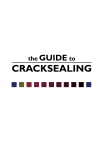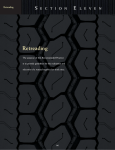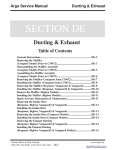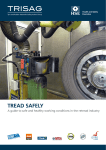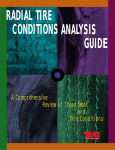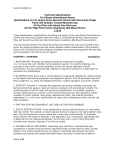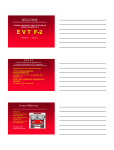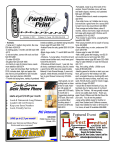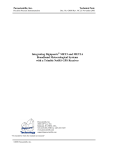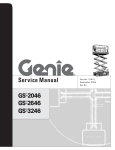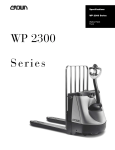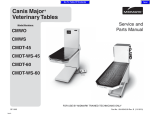Download Miscellaneous
Transcript
Miscellaneous S E C T I O N Miscellaneous The following section explains the use of chains on radial truck tires. Chain use is designed to offer additional traction, providing the chains and tires are matched appropriately for size and fit. General precautions to tire siping, dynamometer testing and mixing radial and bias ply tires are also addressed. Finally, this section explains the variances in sound levels produced by radial truck tires, and the conditions under which truck noise occurs. 94 T W E L V E S E C T I O N USE OF CHAINS ON RADIAL TRUCK TIRES The use of tire chains can be helpful in providing additional traction in severe weather conditions (such as ice and heavy snow) especially when traveling in hilly or mountainous terrain. Tire chains can be used safely and successfully with Goodyear radial truck tires provided several simple and important points are followed. Always select chains that are specifically designed for radial tires. These chains normally have shorter cross chains than older designs and allow the position of the side chains to be higher on the tire sidewall. This is out of the high-flex sidewall area of a radial tire and results in less susceptibility to sidewall damage. Be sure to use the proper chain size for the tire on which it is being attached. Tighten chains when they are first applied, then after a short run-in period, readjust to ensure a continued snug fit on radial tires. Serious sidewall damage may result from loose chains. Check for adequate dual spacing, especially if using single tire chains on each tire of a dual assembly. The greater deflection of the radial tire may require more dual spacing in marginally-spaced dual assemblies. Finally, always remove chains as soon as they are no longer needed. T W E L V E Miscellaneous TIRE SIPING Tire siping is a process of making small knife-like slits in the tread rubber surface. Normally this is accomplished by a machine that uses sharp, highspeed rotating discs to make cuts that are at an angle of 90° to the circumference of the tread. Siping cuts are normally controlled so they are spaced a specific distance apart from one another. They also will vary in depth across the tread face. Proponents of tread siping have claimed various performance improvements for truck tires. These claims include improved treadwear and reduced irregular wear. Also, it is often claimed that siping improves traction for winter and wet driving conditions on certain road types. At present, the majority of truck tire siping is done in the westernmost Midwest states and the Northwest corridor. It is popular in certain areas, and especially during the winter months, to sipe both steer and drive, and sometimes trailer tires. Goodyear’s position on siping is that it may, under certain operating conditions, improve tire performance. However, under the vast majority of truck operating conditions, new tires are designed and produced with tread patterns and tread compounds that do not require tread siping to give satisfactory performance. Actual testing indicates that siping may improve the tire’s resistance to irregular wear on free-rolling wheel positions that are susceptible to irregular wear due to the combination of operating service and tire application. Specifically, siping may help reduce irregular wear on trailer axles where light, one-way loads are encountered, such as grain trailers or belly dumps that operate under extreme load variations from unloaded to loaded conditions. 95 On the other hand, siping is generally believed to detract from treadwear on lug type tires used on drive-wheel position. This is because siping tends to break up the tread pattern and cause increased bending of the tread elements. This results in faster wear due to increased scuffing as the tire goes through its footprint under torque. The effect tread siping has on tire performance can vary considerably with the particular tire pattern being siped. For example, in a heavily bladed tread pattern it is believed that siping in the original tread state could hurt treadwear. Other tread patterns, such as those having a much higher net-to-gross footprint area, might be more adaptable for siping under the service conditions discussed earlier. If a customer chooses to sipe his Goodyear tires, we strongly recommend that he pay close attention to the type of siping used. Specifically, our experience is that siping should be performed laterally across the tread, although angles that vary somewhat from this might also be acceptable. However, to the best of our knowledge, siping that is more or less circumferential has not been demonstrated to be successful. Also, our experience shows that siping with varying depth across the face of the tread usually yields better results than constant depth siping. This also appears to provide the minimum risk for increasing the tire’s susceptibility to tread rubber chunking. It is important to note that the Goodyear warranty provides protection for the user against failures from workmanship or material conditions. If a tire failure occurs because of a condition beyond Goodyear’s control, such as siping, the warranty is null and void. Miscellaneous S In recent years, a number of retread rubber manufacturers have produced precure tread rubber that is siped when molded. Various claims of improved treadwear, fuel economy, etc, have been made. Our experience indicates that while these claims may be true in specific instances, it is largely a matter of siping the tread in such a way that is compatible with the particular tread rubber compound and tread pattern design being used. In other words, if tread siping is considered an integral part of the manufacture of new tread rubber at the outset, the siping can be more or less customized to the type of rubber and type of pattern so that performance can be optimized. In summary, tire siping may have certain performance advantages in improved treadwear and/or traction; however, these can be expected to vary considerably, depending on the particular type of tread rubber, the tread pattern, and the service conditions in which the tire is used. A customer considering siping tires should consult the new tire or retread rubber manufacturer to discuss appropriate siping machinery and techniques for the individual situation. E C T I O N T DYNAMOMETER TESTS MIXING RADIAL AND BIAS PLY TIRES Dynamometers are used by truck manufacturers, and frequently by truck distributors or large fleet operators, to test the engines and other parts of the driveline. Dynamometer rolls vary in size from 8-5/8-inch to 50-inches. The smaller rolls have a greater potential for damaging the tires. During a dynamometer check, there is little weight on the tires and only a small area of the tread face (usually the center rib or center portion of the tread) is in contact with the roll. Excessive heat builds up in this small area. If the test runs too long, the excessive heat can damage the tire to the point where it could fail later on the highway. The maximum safe time for running tires on a dynamometer roll varies with the roll diameter, speed, the power or torque transmitted from the tire to the roll, and, to some extent, the load and inflation. Figure 12.1 shows general rules for limiting the time for maximum power testing. Due to differences in cornering force characteristics and spring rates, the best tire and vehicle performance will be obtained by applying tires of the same size and construction (radial ply/bias ply) to all vehicle wheel positions. However, different tire constructions are permitted on the steer, drive, and trailer axles of two-axle, tandem, and multiple-axle combinations when the following rules are observed. • Never mix different tire sizes or tire constructions on the same axle. • If radial tires are mixed with bias tires, the best handling will be obtained with the bias tires on the steer axle. • Bias or radial tires may be used on either axle of two-axle vehicles, providing the vehicle has dual rear wheels or is equipped with Super Single wide-base tires. • Either bias or radial tires may be used on the steering axle of vehicles with three or more axles. Either all bias or all radial tires should be used on the nonsteering axles. • Never mix bias and radial tires in a tandem or multiple axle combination. Always check with the vehicle manufacturer before changing tire size or construction on any vehicle. Carefully evaluate performance changes caused by tire size or construction changes before putting the vehicle back into service. 50 – 60 MPH – Time Limit at Max Power Roll Dia 8 5/8'' 18'' - 20'' 30'' - 36'' 48'' - 50'' 3 Min 5 Min 10 Min 15 Min Figure 12.1 For 50 percent power, the time can be doubled. For 25 percent power, the time can be quadrupled. 96 W E L V E S T E C T I O N Miscellaneous W E L V E NOISE Tires are one source of noise emitted by a truck operating at speeds above 35 MPH on a highway. In addition to the tires, other major sources of noise are: • Engine • Radiator fan • Engine exhaust • Engine air intake • Driveline • Aerodynamics (wind noise) Noise is defined as a disagreeable sound. Pressure waves in the air produce sound. The human ear is designed to sense these pressure waves and transmit signals to the brain indicating the magnitude and characteristics of the sound. The ear mechanism can detect very faint sounds with very low air pressure energy levels and yet can detect and withstand relatively loud sounds with high energy levels without becoming damaged. To accomplish this wide range of hearing, the ear mechanism/brain response is not directly proportional to the sound pressure, but is less sensitive at the louder end of the range. The total noise output of a truck is usually measured with an instrument called a sound level meter. The input to the sound level meter is through a microphone that is placed nominally 50 feet from the center of the highway lane that is being monitored. The sound level meter has electronic circuitry designed to approximate the human auditory system. Thus, the input is varying air pressure caused by the sound — through a microphone — and the output is a value indicated on a scale that gives the sound level of the noise. The sound level or more precisely, the sound pressure level, indicates the degree of loudness to the human ear of a given sound. 400 300 Measured Sound Pressure Reference Sound Pressure Sound Level = 20 LOG10 Bias Ply Production Cross Rib Note: The reference pressure is usually taken as the sound pressure at the threshold of hearing: the quietest sound that can be heard, 0.0002 microbar of pressure. 200 Radial Cross Bias Ply Rib Radial Rib 100 68 70 72 74 76 78 80 Sound Level Decibels (A) Figure 12.2 Relative sound pressure vs. sound level in dB(A) from SAE J57 tests. Sound level units are measured in decibels, abbreviated dB. Since the human ear does not respond the same for all frequencies of sound, the sound level meter has been modified to agree closely with the frequency response of the human auditory system. When the frequency adjustments are included, the suffix (A) is added to the dB unit: dB(A). The relationship of sound pressure to sound level in the region caused by the tires of a truck is shown in a relative fashion by the curve in Figure 12.2. Note the relative increase in noise, going from the relatively non-aggressive radial rib tire to the bias ply rib tire; to the radial cross rib; to the bias ply cross rib tire. Also note the nature of the curve wherein greater changes in sound pressure are required to cause a given change in sound level at the higher sound pressures than at the lower sound pressures. 97 The data for the curve were obtained from standard SAE J57 tests using a truck with four test tires on drive axle and two rib tires on steer axle. The test consisted of a 50-mph coast-by with microphone at 50 feet from the line of travel. When several sources cause sound waves to impinge on the ear simultaneously, the ear perceives the sum total of sound air pressure on the ear drum; the pressures are additive. However, the sound level perceived by the overall auditory system is increased only according to the logarithmic rule demonstrated by the curve. Therefore, when sounds are emitted by various sources in a truck, the combined effect can be obtained by adding sound pressures and then converting the total sound pressure to dB(A). If individual sources of sound have already been computed or measured in dB(A), the combinations of these sounds in terms of dB(A) cannot be obtained by addition of the individual dB(A) values. S Miscellaneous Typical sound levels of various over-the-road truck components and the effect on total sound level of combining these noise sources are shown in Figure 12.3. The tire noise value listed assumes the use of eight bias ply cross-rib drive tires on the truck. Speeds Above 35 MPH – Six Predominant Noise Sources Engine 80 Fan 79 Exhaust 80 Intake 80 82 86 83 Driveline Tires 83 87-90 dB(A) 75-86 Figure 12.3 Combining noise sources. Typical methods used to reduce truck noise to meet limits prescribed by law are as follows: • Reduce speed • Retrofit equipment • Improve maintenance • Remove irregularly worn tires • Restrict lug tires to drive axles • Use radial tires on all axles • Use rib tires on all axles • 87-90 dB(A) Laws on noise are established by the Federal government, and are administered by the Environmental Protection Agency (EPA). Active enforcement, however, generally is the responsibility of state highway authorities. E C T I O N Since the enactment of the Noise Control Act of 1972, the EPA has been empowered to issue regulations controlling the operational noise levels of interstate rail and common carriers, and the noise emissions of newly manufactured products. To do this, the EPA must identify a certain area of commercial endeavor or a certain product as a “major noise source.” It then has the authority to pursue regulatory activity to control and monitor that area or product. Early on, the railroads, airports, certain manufacturing operations, and a host of other activities were identified as major noise sources in need of regulatory attention. The Agency specifically labeled medium and heavy trucks as significant sources of environmental noise and has set up standards for the testing and control of the “total vehicle noise emission package.” These standards, known as the Interstate Motor Carrier Noise Emission Standards, are contained in Volume 40, Parts 202 and 205, of the Code of Federal Regulations. They have been in force since 1975, and apply to all vehicles in over-the-highway service as well as to newly manufactured vehicles. They set definite limits for total noise levels at various speeds and under stationary conditions. The legislation for in-service interstate motor carriers requires that overall external noise levels for trucks manufactured previous to the 1986 model year not exceed the following values, measured at a distance of 50 feet from the vehicle centerline: • 90 dB(A) on highways at speeds greater than 35 mph • 86 dB(A) on highways at speeds of 35 mph or less • 88 dB(A) during stationary runup at governed engine rpm 98 T W E L V E For trucks of 1986 model year manufacture and later, the standard requires that the external noise level values must not exceed: • 87 dB(A) on highways at speeds greater than 35 mph • 83 dB(A) on highways at speeds of 35 mph or less • 85 dB(A) during stationary runup at governed engine rpm New medium and heavy duty trucks (vehicles with GVWR of 10,000 lbs. or greater) must meet noise emission standards based on a vehicle acceleration and pass-by test at speeds of up to but not exceeding 35 mph. The noise measurement is taken at a distance of 50 feet from the centerline of vehicle travel, and the test is performed by the vehicle manufacturer himself and certified to the EPA. For medium and heavy duty trucks produced prior to January 1, 1988, manufacturers had to test their vehicles to a maximum external noise level of 83 dB(A). For trucks manufactured after January 1, 1988, the maximum external noise level permitted is 80 dB(A). S E C T I O N T W E L V E Miscellaneous TIRE STORAGE RECOMMENDATIONS For Tires Not Installed on Vehicles 1. Oil, Solvents and Grease Mounted or unmounted tires should never be stored on oily floors or otherwise in contact with solvents, oil or grease. Nor should tires be stored in the same or adjoining rooms with volatile solvents. These solids, liquids or vapors are readily absorbed in rubber and will damage and weaken it. 2. Ozone Mounted and unmounted tires should be stored away from electrical devices such as motors, generators, arc welders and switches because they are active sources of ozone. Ozone attacks rubber causing it to crack perpendicular to any applied stress. Such cracking exposes the new rubber surface at the base of the crack to greater stress and consequently to more severe ozone attack until eventually the cracks can penetrate to the carcass where continued rubber degradation could cause carcass failure. Minor, ozone induced, surface cracks will seldom cause tire failure, but can form an access route for foreign material to penetrate the carcass once the tire is placed in service. 3. Heat and Light Tires should be stored in a cool place, away from direct sunlight or strong artificial light. Both heat and light are sources of oxidation of the tire surfaces. The oxidation is characterized by a “crazed” or “alligatored” surface which does not penetrate the rubber deeply. The severity of the oxidation is, of course, a time- and temperature-dependent variable. Long term storage at ambient temperatures have been equated to short term storage at elevated temperatures. For instance, three days storage at 158˚ F causes approximately the same loss in tensile strength as three years storage at 75˚ F. Oxidation may cause sufficient damage to the inside of an unmounted tire as to cause early tube failure or a slow leak. 4. Undue Stress in Storage If possible, tires should be stored vertically on treads. Severely stressed and distorted tires are subject to much greater damage from solvent, ozone or oxidative attack than those which are not stressed or are stressed minimally and uniformly. Unmounted tires stacked horizontally (on sidewall) should be piled symmetrically and never so high as to cause severe distortion to the bottom tire. Tires that are mounted on rims but not on vehicles should follow the same recommendations as for unmounted tires. 5. Foreign Material - Dirt, Water Unmounted tires should be stored under a waterproof covering. Dirt is not harmful to a tire. However, dirt on the inside of a tire placed in service can cause early tube failure or a slow leak. Water on the inside of a tire in service can be turned into steam which can quickly destroy the strength of both the rubber and the textile members of the tire. Additionally, water and dirt inside a tubeless tire can cause corrosion to tubeless rims and plug tubeless values, both a source of potential tire failure. Foreign material on the tire bead seat could affect air seal and cause air loss. 6. Inflation If tires are mounted on rims and inflated, pressure should be maintained at 10 PSI. If tires are inflated and put in storage during warm weather, the initial inflation should be about 15 PSI to offset the drop in pressure which will occur during the cold weather months. 7. Protective Cover If tires are stacked, first lay a foundation of clean wood to protect them from dirt, oil, grease, etc. Tires should be covered with an opaque or black polyethylene film. PVC or any other clear film is not satisfactory. The polyethylene film will protect against ozone generated by 99 electrical sources and cut down on air circulation which will minimize both the available oxygen and ozone which degrade rubber. 8. Do Not Use Paint to Preserve Tires For Tires Installed on Vehicles 1. The storage area surface under each vehicle should be firm, reasonably level, well drained and free of all oil, fuel or grease. Clean 1/4'' - 3/4'' gravel under each tire is desirable if the area is not paved. Storage should not be permitted on blacktop or oil stabilized surfaces. 2. When storage longer than 6 months is anticipated, the vehicle should be blocked up so weight does not rest on the tires and inflation pressure reduced to 15 PSI. Storage of such vehicles should be under cover if possible. Otherwise, tires should be protected from elements by an opaque waterproof covering. 3. If it is not possible to block up the vehicle, inflation pressure in the tires should be increased to 25% above the inflation required for the actual load on the tire in the storage condition. 4. Vehicles should not be moved during extremely cold weather. Under moderate temperature conditions, vehicles may be moved if necessary. 5. Inflation in the tires must be adjusted to the recommended service pressure before shipping or putting a stored vehicle into service. 6. Both tires and vehicles should be used on a first-in, first-out basis to avoid excessive aging due to storage. 7. Based on varying weather conditions, if tires are stored uncovered on vehicles under load, some weathering may occur at approximately one year storage period. Miscellaneous S E C T I O N WHEN DOES THE WARRANTY END A tire has delivered its full original tread life and this warranty ends when the tread wear indicators become visible, or five (5) years from he date of original tire manufacture or original new tire purchase date (whichever comes first). How Do I Know When My Tires Were Maufactured? Tires with a Department of Transportation (DOT) number ending with 0100 or later were manufactured after 1/1/2000. 0100 is the 4-digit production date in week-week-year-year format. 0100 means the tire was produced in the 1st week of 2000. Prior to January 2000, a 3-digit date code was used following a week-week-year format. thus, 019 means the tire was produced in the 1st week of 1999. TIRE SEALANTS AND BALANCE MATERIALS There are many vendors that sell aftermarket tire sealants and balance materials that can be added or pumped into a tire. Goodyear does not endorse any product, but if you wish to use such a product as either a sealant or tire balancer, the Goodyear warranty is voided if the material adversely affects the tire inner liner. 100 T W E L V E







